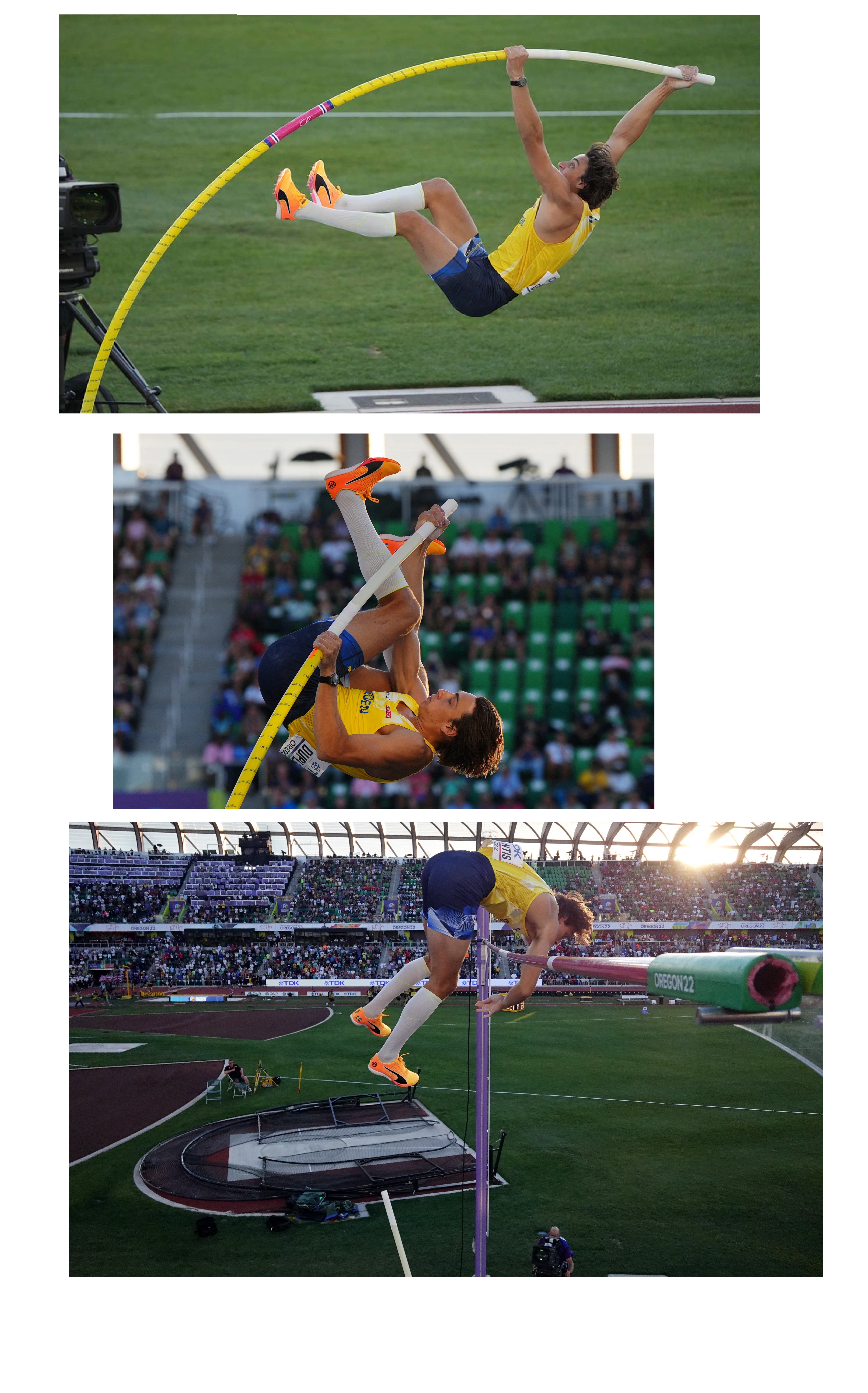
Pole vault
Pole vaulting, also known as pole jumping, is a track and field event in which an athlete uses a long and flexible pole, usually made from fiberglass or carbon fiber, as an aid to jump over a bar. Pole jumping competitions were known to the Mycenaean Greeks, Minoan Greeks and Celts. It has been a full medal event at the Olympic Games since 1896 for men and since 2000 for women.
This article is about the sport. For the Cold War era communications system, see Pole Vault (communications system).
Athletics
Pole vault
![]() Armand Duplantis 6.24 m (20 ft 5+1⁄2 in) (2024)
Armand Duplantis 6.24 m (20 ft 5+1⁄2 in) (2024)
![]() Yelena Isinbayeva 5.06 m (16 ft 7 in) (2009)
Yelena Isinbayeva 5.06 m (16 ft 7 in) (2009)
![]() Thiago Braz 6.03 m (19 ft 9+1⁄4 in) (2016)
Thiago Braz 6.03 m (19 ft 9+1⁄4 in) (2016)
![]() Yelena Isinbayeva 5.05 m (16 ft 6+3⁄4 in) (2008)
Yelena Isinbayeva 5.05 m (16 ft 6+3⁄4 in) (2008)
![]() Armand Duplantis 6.21 m (20 ft 4+1⁄4 in) (2022)
Armand Duplantis 6.21 m (20 ft 4+1⁄4 in) (2022)
![]() Yelena Isinbayeva 5.01 m (16 ft 5 in) (2005)
Yelena Isinbayeva 5.01 m (16 ft 5 in) (2005)
![]() Armand Duplantis 6.22 m (20 ft 4+3⁄4 in) (2023)
Armand Duplantis 6.22 m (20 ft 4+3⁄4 in) (2023)
![]() Jennifer Suhr 5.03 m (16 ft 6 in) (2016)
Jennifer Suhr 5.03 m (16 ft 6 in) (2016)
It is typically classified as one of the four major jumping events in athletics, alongside the high jump, long jump and triple jump. It is unusual among track and field sports in that it requires a significant amount of specialised equipment in order to participate, even at a basic level. A number of elite pole vaulters have had backgrounds in gymnastics, including world record breakers Yelena Isinbayeva and Brian Sternberg, reflecting the similar physical attributes required for the sports.[1][2] Physical attributes such as speed, agility and strength, along with technical skill, are essential to pole vaulting.
Technology[edit]
Competitive pole vaulting began using solid ash poles. As the heights attained increased, bamboo poles gave way to tubular aluminum,[7] which was tapered at each end. Today's pole vaulters benefit from poles produced by wrapping pre-cut sheets of fiberglass that contains resin around a metal pole mandrel, to produce a slightly curved pole that bends more easily under the compression caused by an athlete's take-off. The shape of the fiberglass sheets and the amount of fiberglass used is carefully planned to provide the desired length and stiffness of pole. Different fiber types, including carbon-fiber, are used to give poles specific characteristics intended to promote higher jumps. In recent years, carbon fiber has been added to the commonly used E-glass (E for initial electrical use) and S-glass (S for solid) materials to create a lighter pole.
As in the high jump, the landing area was originally a heap of sawdust or sand where athletes landed on their feet. As technology enabled higher vaults, mats evolved into bags of large chunks of foam. Today's mats are foam usually 1–1.5 meters (3 ft 3 in – 4 ft 11 in) thick. They are usually built up with two cross-laid square section logs with gaps between them, topped by a solid layer of foam of the same thickness. This lattice construction is wrapped in a close-fitting cover topped with nylon mesh, which allows some air to escape, thus combining both foam and a measure of air cushioning. The final layer is a large mat of mesh-covered foam which is clipped around the edges of the complete pit and prevents the athlete from falling between the individual bags. Mats are growing larger in area as well to minimize risk of injury. Proper landing technique is on the back or shoulders. Landing on the feet should be avoided, to eliminate the risk of injury to the lower extremities, particularly ankle sprains.
Rule changes over the years have resulted in larger landing areas and additional padding of all hard and unyielding surfaces.
The pole vault crossbar has evolved from a triangular aluminum bar to a round fiberglass bar with rubber ends. This is balanced on standards and can be knocked off when it is hit by a pole vaulter or the pole. Rule changes have led to shorter pegs and crossbar ends that are semi-circular.